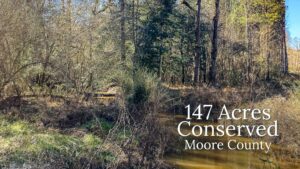
By: Crystal Cockman
“Brr… that’s cold!” US Fish and Wildlife Service endangered species biologist Sarah McRae exclaims putting on her damp gloves for day three of a week long survey for an interesting species known only from the Neuse and Tar River basins in North Carolina – the Neuse River Waterdog (Necturus lewisi).

Accompanying Sarah on day three means we’re fairly likely to find one of these cute little creatures, considering historical records from these sites confirm they have been here in the past. This is fieldwork even a layperson can help with, as these unique fully aquatic salamanders are not going to be mistaken for anything else. There is nothing else like them in these waters.
Fairly large for a salamander, these guys can be up to nearly a foot in length. Their bodies are reddish brown, and they have very distinctive red feathery looking external gills just behind their head. There are similar species found in other areas of North Carolina and beyond, and in some places they are better known as “mud puppies.”
Although their typical diet consists of snails, worms and small fish, the traps set out for them by biologists are filled with old chicken livers – a stinky proposition for us setting the traps, but a good lure for these guys considering we need to find them in short order. This particular survey only lasts a week in these

six locations, but the overall survey for these critters has been going on for five years, as biologists seek to confirm their presence or absence in an effort to understand distribution and whether they are in need of classification under the endangered species act for protection.
This species occupies clean and swift flowing streams, and requires high oxygen levels and high water quality. They prefer to inhabit streams with burrows and log jams, and areas of submerged leaves in eddies or backwater areas. They attach their eggs to the undersides of objects in low or moderate flow areas of streams.
Past field work by Alvin Braswell in the late 1970s and early 1980s showed this species as present in at least 140 locations in the Neuse and Tar-Pamlico river basins. Although it is too early to confirm the results of these new surveys, the trend seems to be that the species has moved out of some of the headwaters and are still found mainly in the larger river sections. Pollution from runoff and urbanization, water development projects including impoundments and stream channelization, and other loss of habitat and water quality threaten this species’ viability.
On our adventure last week, the first two stops did not yield any waterdogs. We baited the traps that needed more, released crayfish and pirate perch bycatch, and trudged on to the next nearby spot. At our third location, just after Sarah got frustrated we hadn’t found anything yet, I pulled up number 7 of 10 of the traps, and there she was! A be

autiful salamander and an exciting new “lifer” for me (a term which means a first ever sighting of a new species, a record for your “life list”).
Finding this little girl meant we needed to go back through and pull out all the traps at this location, since all we needed to know is whether they were here or not. Privet and greenbrier challenged our steps on these steep banks, and a new pair of waders was one casualty of this work. But we didn’t mind so much, after finding what we were looking for and confirming another known location that this special species still persists.
The next two places we stopped at did not pan out – no waterdogs this day for those locations, but there are still two days left in Sarah’s survey’s for the week. We add in more stinky chicken livers in hopes that Sarah and her help will find another one of these unique critters tomorrow.
For today, we pack up our cold gloves and take off our soggy boots and waders, as I break for a moment when I get a cell phone signal again and share my pictures of my first waterdog on Facebook and Instagram. Species like this one are an integral part of the river system and fill a unique role in this community. Here’s hoping that thanks to Sarah’s efforts, and the efforts of other USFWS and NC Wildlife Resources Commission biologists, these little guys will be around for years to come to benefit the river ecosystem, and for others to see first-hand and take pictures to share with their friends, too, of this interesting and adorable critter.
